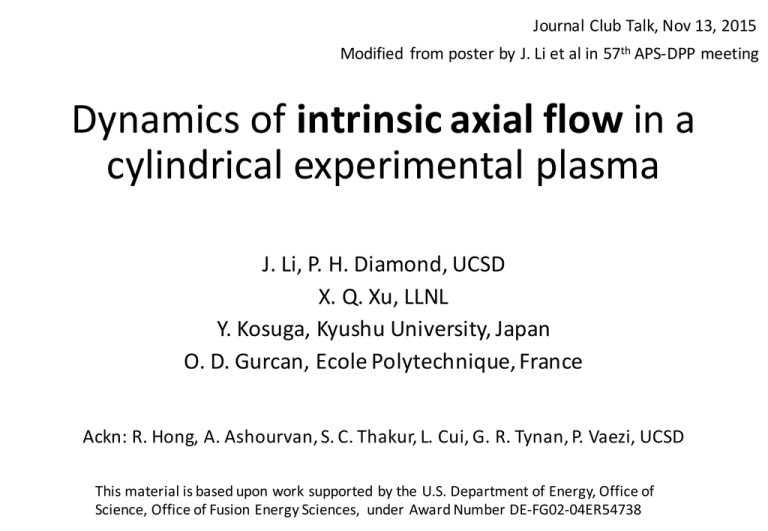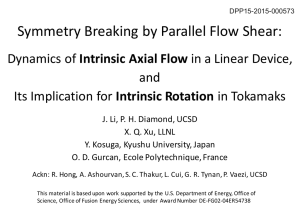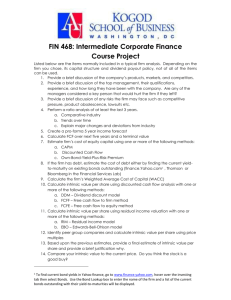intrinsic axial flow cylindrical experimental plasma
advertisement

JournalClubTalk,Nov13,2015
Modified fromposterbyJ.Lietalin57th APS-DPPmeeting
Dynamicsofintrinsicaxialflowina
cylindricalexperimentalplasma
J.Li,P.H.Diamond,UCSD
X.Q.Xu,LLNL
Y.Kosuga,KyushuUniversity,Japan
O.D.Gurcan,Ecole Polytechnique,France
Ackn:R.Hong,A.Ashourvan,S.C.Thakur,L.Cui,G.R.Tynan,P.Vaezi,UCSD
ThismaterialisbaseduponworksupportedbytheU.S.DepartmentofEnergy,Officeof
Science,OfficeofFusionEnergySciences, underAwardNumber DE-FG02-04ER54738
• Background:
Outline
• LinearDeviceConfiguration andResults:CSDX&PANTA
• Problem: Originofaxialflow?
• Reviewofintrinsicrotation
• Residualstress,withapplicabilityofconventionalwisdom
• DynamicalSymmetryBreakingMechanism
• Dynamicalsymmetrybreaking
• Comparetostandardmechanism:negativeviscosityvsintrinsictorque
• NegativeViscosityPhenomena
• Modulational instabilityforatestflowshear𝛿 𝑣# $ <->𝜒& vs|𝜒 ()* |
• Whatstops 𝑣# $ growth? – ParallelShearFlowInstability(PSFI)
• Flowstructure
• Turbulent pipeflowmodel: Δ𝑃# ,neutralboundary layer
• Flowprofile: Including PSFIeffectà 𝑣# $ structure
• Significancefortokamaks
• Conclusion
2
Summary
• Intrinsicflowsuggestedbyexperimentsinlineardevices,
whereconventionalwisdomdoesnotapply
• Dynamicalsymmetrybreaking: Seededbytestflowshear
𝛿 𝑣# $ à Intrinsicflowà 𝛿 𝑣# $ feedsbackonitself
• Perturbedresidualstress𝛿Π ()* ∼ 𝜒 ()* 𝛿⟨𝑣# ⟩′ inducesnegative
viscosityincrement 𝜒 ()* ,totalviscosity 𝜒&tot = 𝜒& − |𝜒 ()* |
• Flowshear 𝑣# $ staysbelowParallelShearFlowInstability
threshold;totalviscositystayspositive
• Fortokamaks:synergyofstandardresidualstressdrivenby
𝛻𝑇, 𝛻P, etc. and𝛿Π ()* inducednegativeviscosityincrement
3
Experiments:configuration
Gasinput
• PANTA[2]
• CSDX[1]
• Gasinputfromthesourceend
• Gasinputfromside
àAxialmomentuminput
àNoaxialmomentuminput
Parameters
CSDXTypical Values
PANTA TypicalValues
Source
<5kW
3kW
Pressure
0.1~1.3Pa
0.1Pa,0.4Pa
B field
Upto2400G
900G
𝑇)
3~6eV
3eV
𝑛)
0.5~2x1019m3
1x1019m3
𝑇E
0.3~0.8eV
---
*[1]S.Thakuretal,PlasmaSourcesSci.Technol.23(2014)044006;
[2]T.Kobayashi (2014,Jun).Parallelflowstructureformationbyturbulentmomentumtransportinlinearmagnetized
plasma. AsiaPacificTransportWorking Group,Kyushu University, Japan.
4
ProfileofAxialFlow
Endplate
cs ~ 3 km/s
• CSDX[1]
• Noaxialmomentuminput
• FlowprofilesteepensasBincreases
Source
• PANTA[2]
• Flowreversal
• Inputflow:insufficientmomentuminput
Intrinsicaxialflow!
Origin,physics?
*[1]L.Cui (2015,Nov). SpontaneousProfileSelf-OrganizationinaSimpleRealizationofDrift-WaveTurbulence.Invitedtalk,
Session BI3,57th APS-DPPmeeting,Savannah,Georgia.
[2]T.Kobayashi (2014,Jun).Parallelflowstructureformationbyturbulentmomentumtransportinlinearmagnetized
5
plasma. AsiaPacificTransportWorking Group,Kyushu University, Japan.
EvidenceofIntrinsicFlow
Device
CauseofDrivenFlow
CSDX
Neutralgas
EvidenceofIntrinsicFlow
Flow profile,densityprofilesteepenasB
increases:
à Ionized&heatedduringhelicon
discharge
𝛻𝑁 ↑ à DriftWave (DW)turbulence ↑
à Ionpressuregradientinaxial
direction Δ𝑃#
à Drivenflow
PANTA
à Turbulenttransportofaxialmomentum↑
à Intrinsicflowinteractswithdrivenflow
à Totalflowstructurechanges
Gasthruput intothesourceend
Flowreversal
à Externalmomentumsource
à Intrinsicflowinteractswithdrivenflow
à Drivesflow fromsourceto
endplate
à Globalnetflowdirection:
Sourceà Endplate
6
Problem
• Axialflows
• CSDX,PANTAbothsuggesttheexistenceofintrinsic
axialflows
• Questions:
• (1)Whatgeneratestheintrinsicflow?
• (2)Howdoesintrinsicflowinteractwithdrivenflow?
• Clue:
• Analogoustointrinsicrotationintokamaks:axial<-> parallel
Plasma
source,
heating
Axialflow
Parallelflow
7
IntrinsicRotationinTokamaks
• Cancellationexperiment:existenceofintrinsictorque
• NeutralBeamInjection(NBI)à Heating,externaltorque
• 1co+2ctr à 0totalà Intrinsictorque=1coNB
StandardApproach
• Meanflowequation:
𝜕K 𝑣∥ + 𝜕N 𝑣ON 𝑣O∥ = 0
• Intrinsicflowisacceleratedbytheresidualpieceofthe
momentumflux:
𝑑 𝑣∥
()*
𝑣ON 𝑣O∥ = −𝜒&
+ 𝑉S 𝑣∥ + ΠN∥
𝑑𝑟
• Ignoremomentumpinch𝑉S
• CorrelatedbyB fieldstructure,𝑘∥ =
shearlength
•
()*
ΠN∥
∼ 𝑘U 𝑘∥ = ∑\ 𝑘U 𝑘∥|𝜙\
|]
• 𝑥:distancefromrationalsurface
=
V
𝑘U W ,𝐿*
X
] V
𝑘U W
X
= magnetic
𝑥
• Needssymmetrybreaking!
𝑟
9
SymmetryBreaking
• Summaryofconventionalsymmetrybreakingmechanisms*:
Conventional mechanisms
Keyphysics
Electricfield shear𝐸N$
Centroidshiftà parallelacousticwave
asymmetryà mean⟨𝑘∥ ⟩
Intensity gradient𝐼 $
Spectraldispersionfromintensitygradient
Stress frompolarization
acceleration⟨𝐸`∥ 𝛻a] 𝜙`⟩
Guidingcenterstressfromaccelerationdue
topolarizationcharge
Stressfrom𝜕N 𝑣ON 𝑣Oa àBU ⟨𝐽N ⟩
𝑱×𝑩 torque frompolarizationflux
• Preferenceofwavepropagationinparalleldirection, 𝑘∥ ≠ 0
• DonotapplytoCSDXorPANTAß StraightBfields
𝑥
𝑘∥ = 𝑘U
𝐿*
*P.H.Diamond etal,Nucl.Fusion 53(2013)104019;
P.H.Diamond etal,Nucl.Fusion 49(2009) 045002.
10
SummaryofConventionalWisdom
()*
• IntrinsicflowacceleratedbyΠN∥
à Needssymmetrybreaking
• Standardapproach
∼ ⟨𝑘U 𝑘∥ ⟩
()*
à Intrinsictorque,−𝜕N ΠN∥
acceleratesflow
à DoesNOT applytostraightB fields
• DynamicalSymmetryBreaking
• Driftwaveturbulenceinpresenceofaxialflowshear
• 𝛿 𝑣# $ seedssymmetrybreaking
à Negativeviscosityincrement
ModelEquations
• Hasegawa-Wakatani +Axialflow:
Acousticcoupling
• Acousticcoupling
• CoupleaxialflowfluctuationtoDW
• Familiar:Convertparallelcompressionintozonalflow*
• 𝑖𝛿:nonadiabatic electronresponseà Driftwaveinstability
• Dispersionrelation:
Driftwave
*Wangetal,PlasmaPhys.Control.Fusion 54(2012)095015
Symmetry
breaking
Ionacousticwave
12
DynamicalSymmetryBreaking
• Spectralimbalance:
• Growthrate~frequencyshift:
Infinitesimaltestaxialflow
shear,e.g.𝛿 𝑣# $ > 0
• Frequency:
• Frequencyshift~Flowshear:
kU
𝜙\
Modeswith𝑘U 𝑘# > 0 grow
fasterthanothermodes,
𝛾\ |\o \p qr > 𝛾\ |\o\p sr
]
Spectral
imbalance
0
: {𝑘+}
Spectralimbalance(Fig.1)
k#
:{𝑘−}
{𝑘±}:Domainswheremodes growfaster/slower
Fig.1:Spectralimbalance.
0
k#
()* ≠ 0
𝑘U 𝑘# > 0 à ΠN#
13
Quasilinear ReynoldsStress
• Reynoldsstress=diffusiveflux+residualstress
• Turbulentdiffusivity:
• Residualstress:
• Sumover2domains,accountingforthespectralimbalance
Spectralimbalance∼ 𝛿 𝑣#
$
14
Contrastthe2Stories
StandardSymmetry Breaking
Dynamical SymmetryBreaking
Freeenergy source 𝛻𝑇E,𝛻n,…depending onturbulence type Onlydriftwaveturbulence sofar,𝛻n
Symmetrybreaker
Radial electricfieldshear, 𝐸N$ ;
Intensitygradient,𝐼 𝑥 $,etc.
All tiedtomagneticfieldconfiguration.
Testaxial flowshear, 𝛿 𝑣# $;
No requirement forshearof𝑩
structure.
Effect ontheflow
()*
Intrinsictorque, −𝜕N ΠN∥
Negativeviscosity,
()*
𝛿ΠN#
= |𝜒 ()* |𝛿 𝑣#
Flowprofile
𝑣∥
Feedbackloop
$
()*
ΠN∥
=
𝜒&
𝛻𝑇E +geometry
(magneticshear)
Heatflux
Openloop
𝑣∥
$
()*
ΠN∥
$
()*
Flowdrive(Π
,Δ𝑃# )
N#
𝑣# $ =
𝜒& − |𝜒 ()* |
Testflow
shear𝛿 𝑣#
$
Intrinsic
flow,
feedbackon
𝛿 𝑣# $
Closed
loop
Breaks the
symmetry,
spectral
imbalance
Residualstress
()*
ΠN#
15
NegativeViscosityIncrement
()* ∼ 𝜒 ()* 𝛿 𝑣 $,back-of-envelopestyle
• Calculatenegativediffusion𝛿ΠN#
#
• Quasilinear residualstress:
• 𝑁\ ∼ |𝜙\ |]/𝜔\ waveactiondensitygovernedbywavekineticequation:
Convectionby
wavepacket
Refraction
Lineargrowth
Self-interaction
• Recall:
16
NegativeViscosityIncrement:cont’d
• Dynamicsofatestflowshear
(From formalcalculation)
• Negativeviscosityincrement:
• Growthrateofflowshearmodulation
17
Limitson 𝑣#
•
tot = 𝜒 − |𝜒 ()* | < 0 à 𝛿 𝑣
𝜒&
&
#
$
$
grows,profilesteepens,until…
• 𝑣# $ hitsParallelShearFlowInstability(PSFI)threshold
• PSFI:recalldispersionrelationofthemodelwithadiabaticelectrons:
• Unstable↔ discriminant
à PSFI
• à
• PSFIturbulenceà 𝜒&PSFI addsontotheambient𝜒&tot
à 𝜒&tot = 𝜒&DW + 𝜒&PSFI Θ
•
𝑣# $ − 𝑣#
$
„NEK
− |𝜒 ()* |
𝜒&PSFI switchedon,𝜒&PSFI > |𝜒 ()* | à 𝜒&tot > 0
• 𝑣# $ staysbelowPSFIthreshold;totalviscositystayspositive.
• Similartononlineardampingofzonalflow
18
FlowStructureinLinearDevice
PressuredropΔ𝑃#
Plasma
source,
heating
Neutrallayer
Pipe flow Plasma flow
Drive
Plasmaflow
Momentum outflux∼ 𝜌r ⟨𝑣N 𝑣# ⟩
Pressure
drop Δ𝑃#
Ion pressure
dropΔ𝑃#
Boundary Noslip
condition
Setby
neutrallayer
Viscosity
𝜒& − |𝜒 ()* |
𝜈
• IdeaofModel:Turbulentpipeflow,Prandtl +ResidualStress
• Prandtl (momentumbalance):
• Reynoldsstress:
• à Flowprofile:
19
FlowStructure:cont’d
• PSFIà Enhanceturbulentdiffusion,
eff = 𝜒 DW + 𝜒 PSFI Θ 𝑣 $ − 𝑣
𝜒&
#
#
&
&
$
„NEK
• IncludingPSFIeffect:
•
PSFI
𝜒&
nonlinearin⟨𝑣# ⟩′ à 𝜒&eff > |𝜒 ()*| à Profilerelaxes
• 𝑣# $ staysbelowPSFIthreshold
20
ImplicationforTokamaks
• SynergyofΠ ()* 𝛻𝑇, 𝛻𝑃, 𝛻𝑁 and𝛿Π ()* = 𝜒()* 𝛿⟨𝑣# ⟩′
• DWturbulence,𝑩 shear
• Symmetrybreaker
(𝐸N$ ,𝐼 𝑥 $,…)
()*
• à residualstressΠN∥
• DWturbulence
• Testflowshear
• à negativeviscosity|𝜒 ()* |
• Flowprofilesetbymomentumfluxbalance:
• Enhancedflowprofile
Applicableto
electronDW’s
à CTEM
à Mechanismto
enhanceintrinsic
rotationpredictions
21
Conclusion
• ResultsfromCSDX,PANTAsuggestintrinsicaxialflow;
• Intrinsicmechanismtogenerateaxialflowsandtobuildupa
meanflowprofileisintroduced:
• Testflowshear𝛿 𝑣# $seedssymmetrybreakingandfeedsbackon
itself;
• Differentfromstandardsymmetrybreakingmechanism:
• Intrinsictorque−𝜕N Π()* drivenby𝛻𝑇, 𝛻P, … v.s.Negativeviscosity
increment 𝜒 ()* inducedby𝛿Π()* ;
• Flowstructureinalineardevice:
• Implicationfortokamaks:
• SynergyofΠ ()* 𝛻𝑇, 𝛻P, … and𝛿Π()* = 𝜒 ()* 𝛿 𝑣# $;
• Enhancedintrinsicrotationprofile:
22




